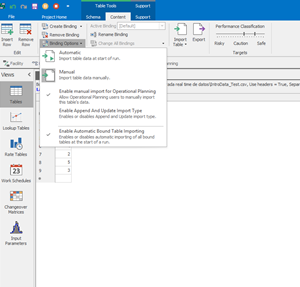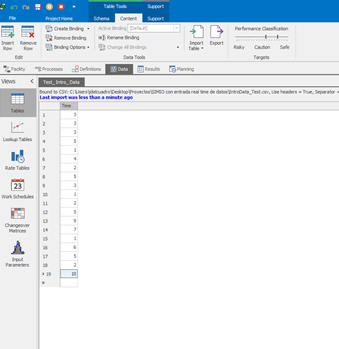Search the Community
Showing results for 'tally wait times'.
-

Process only during a range of time
Heidy Martinez replied to Heidy Martinez's topic in SI General Discussions
Thanks, but I tried with a decide step before the tally that verify State>0. And it works perfectly. How ever, Where comes from the .lastrecordedvalue? Because it didn't appear in the expression tab but the Simio's model accept the expression and it surprised me pleasantly -

Process only during a range of time
Heidy Martinez replied to Heidy Martinez's topic in SI General Discussions
Hi, It works using ProcessName.Enabled. I think It could work also with the delay step generally, but in my case I cannot do it in that way because the process with the period time was related to a server that accomplished the funtion of allow passing depending of the type of entities to my system model. Thanks a lot, for both of you, for your answers. Sorry to bother you again, but I just wondering If someone know how can I exclude the zero numbers on a tally wich value is determinated by a state. I tried in the Tally's advance options in exclussion expression like State==0 and also as Tally==0, but inmediately does not appear in the results tab -
Hi M_A, The sequences in your table are never assigned to the entities before or as they are created. Assigned the sequences by selecting the entity instances in the Facility view, and set the Initial Sequence property under Routing Logic to 'Sequence1'. Also, the Entity Destination Type property on all of your Transfer Nodes, including the outputs nodes of all Servers, must be set to 'By Sequence' in order for the entities to follow the sequence appropriately. Here are a few other things I noticed while looking over the model: All of your Servers only have the capacity to process 1 entity at a time, so for your case only one employee can work in that area at one time. As soon as each employee is done working they will request a pick up 1 at a time. May not be what you are looking for here. The processing times at the Servers aren't linked to the table. You can link them by setting them to 'Sequence1.ProcessingTime'. Be sure to set the appropriate units in the column properties of ProcessTimes. It is hard to see the network that is available for the Vehicle, so one more thing to check is that the Vehicle has all of the needed paths to pick up and drop off the entities. Thanks, Ryan
- 6 replies
-
- sequence table
- model trace
- (and 3 more)
-
task sequence Multiple Operations on Single Entity
ayaraneri posted a topic in SI General Discussions
I have an application where a single entity gets worked on by two different operators at the same time with different completion times. This occurs on 10+ workstations in the flow line in the application. What is the best mechanism to model this in Simio? Ideally, I would like to be able to adjust the processing time of each operator to engage in line balancing, and the ability to create standard WIP processes. Thanks, Aytac -
Hi M_A, It is difficult to determine what could be causing this without seeing the model. Here are a few things I suggest investigating: Ensure that your model run time is set run long enough for all of your entities to flow through your system. To test this, I would set your model run time to Infinity, and create 1 set of 35 employees. Then see how long it take for the model to cycle through all entities. You may be able to use some Animation at this step to see where the entities are getting stuck. Along with #1, I suggest turning on the Model Trace and reviewing the steps taken for each of your employees and the bus. If you are using an unbounded random distribution (for example a normal distribution) for any of your processing times, then the result of that distribution could be something very large. You should be able to see if that is the case within your Model Trace review as well. Lastly, make sure all of your Transfer Nodes are set to route By Sequence and require the bus for transport. Hope this helps. Thanks, Ryan
- 6 replies
-
- sequence table
- model trace
- (and 3 more)
-
12-hour Shifts with Lunch Breaks and Vehicle Transport
Ryan Welch Lutttrell replied to M_A's topic in SI General Discussions
Hi M_A, 1. This is one is a bit difficult to provide direction on without seeing how the rest of the model is structured. If all your processing times are deterministic and you are using a sequence table to route your entities, then you should be able to add the lunch break into the sequence. Similarly, make sure the sink is included at the end of all your entity sequences. Also, make sure the model run time is long enough to process all employees. That may be why they aren't showing up at the sink. 2. Change your interarrival time to 12 hours, and set your Maximum arrivals to 2. Thanks, Ryan -
You can just use a process with a WAIT step. On entity arrival you will fire and event and the process will go on. I also belive that a worker is derived from entity so you can use workers instead of entities. Or the best fitting thing is to use consume step to consume a material (the tools). And have two inventories for it (one near the machine, one in the warehouse of tools). There are some simbits with the basic inventory concepts.
-
I am trying to model a repair process. A major part of this process is the time to get the tools from their storage locations to the machine that needs repair. My thought was to have the tools be modeled as entities that a fork lift or worker has to go grab and bring back to the server. The problem is I need to wait for all those entities to be there before the server can start to process. Then I want to destroy the entities because they aren't actually being processed (only 1 entity would be processed as a representation). Does anyone have a suggestion on how this might be accomplished? Thanks.
-
Hi Jeff, I am studying your model right now and I would like to kindly ask you If you could explain to me some aspects of it. 1. when you add the InfrequentFailureType property inside the multifailureserver model, why is this property a list? I do not understand this. 2. If I want, in this case, my FILLERS, to have 2 types of failures, both triggered by amounts of weight filled to container entities (this is the ideal, but it could also be by number of times that filler fills the container entity), what should I have to change from your model? Thank you so much! Tere
-
Wait, actually this doesn't work. Check the attached model: Create a new ContainerEntity with a string state named whatever you like; Assign NewContainerEntity.NewStringState = Filler.Name when entering the filler. Use this expression any time you need the name of the last station that entity visited. Get Station Name.spfx
-
Hi all, I am wondering of there is a way to create something comparable to a"wait" resourcestate. Maybe by defining or monitoring the "waiting time" of a server. Thankyou in advance!
-

Off Shift Rule Secondary Resources
asneath replied to james.waller's topic in SI General Discussions
Double check that each Resource is hooked to the correct Work Schedule, and that you have the intended Day Pattern inputs for Mon - Sun in your Work Schedule(s). It sounds like you might need a separate (two total) Work Schedule for each group of 5 Resources. I would also recommend visually verifying that the Resources go OffShift (turn white) at the intended times. Other than that just make sure that the Off Shift Rule, in the Server's Secondary Resources, is also set to 'Suspend Processing'. Another way to check that the Server has suspended processing is to put some Dynamic Label Text on the Entity like 'ModelEntity.ID' so you can see exactly which Entity is in the Processing.Contents queue of the Server before and after the shift change. It should be the same one! Happy modeling! -
Hello everyone, I am a master's student in operations management trying my hand at Simio for the first time. I want to develop a model that simulates the delays incurred by variable supply lead times which may lead to stock-outs at a manufacturing plant. I would like to model demand so that each entity generated by a single source module corresponds to a sales order. Each order should have a probability to include orders for several specific product types (since sales orders may contain orders for different product types). As such, entities should have an arrival rate which corresponds to the arrival rate of orders at the company, and the product mix of each order should reference the probability of a given product type being included in that order (i.e. product A has 25% probability to be included, product B has 50%, etc.). Is it possible to do this? I would also like for each product type to be associated with a specific BOM. I.e., a server module should reference each entity instance to consume material as defined by the BOM’s of the products stated by the entity instance. I have defined each component as material elements and defined a BOM for each finished product that references the materials needed. However, in the server module I am only able to input a specific type of finished product as material requirements... Your help is greatly appreciated!
-
The main problem I see with task sequences is I don't see a way to reschedule tasks for later. I used the "Token Wait Action: No Wait" setting on an execute step, then executed the Seize->delay->release process in that step. This does what I wanted. Thanks for taking the time to help.
-
Visualize Utilization in Facility Window or Dashboard Reports I have a source – several servers – sink model. It’s a model of an assembly line production meaning that the entity cannot continue to Server 2 if Server 2 is occupied. The servers have different production times and I want to compare the different utilizations of the servers. I did this over the experiment window and the expression Server1.ResourceState.PercentTime(1) . In a next step I want to visualize these utilizations next each other with something like a bar chart. I came up with two possible ways of doing so but both didn’t work. In the facility window with the animation tools like the linear gauge. The problem here is probably that the expression “PercentTime” has no reference to what the overall time is, while the model is running, and therefore the gauge shows constant 100% the whole time. Or in the experiment window in the dashboard reports which doesn’t have percent time as a response. Is there any other way of visualizing the utilization?
-
Check my attached model. I'm not sure if this was the best approach, but it works. I created two events: One is triggered 100 times to executes another process 100 times. Each process will run its own Delay step and fire the second event to trigger the source. Let me know if this isn't what you need. 100 entities.spfx
-
Hi All, I have a query. Is there a way to implement logic that allows the model to vary the processing time of a server as a function of the available man power? In my model I have various servers and all need a specific number of workers in order to begin processing. I have one large pool of workers to be shared between all stations. This means that there are times when all the workers are in use and times when some are spare. Ideally I would like to model that when there are men spare they would come and help other stations and get the job done quicker or when only some of the required quota of workers are seized they can start the work all be it at slower pace until the full quota has been seized. I hope this makes sense Thanks
-
New to Simio and learning as I go. The attached model includes a CombinerNode1 that batches entities in groups of 2 & 5 (random.discrete). I would like Server1 to use different processing times for the different batch sizes. For example, a batch of 2 entities should be processed in 5 seconds; Batches of 5 entities in 7 seconds, etc.. Eventually I will create batches of up to 6 entities. I have tried using Server1.Processing.Contents for Processing Time, but seems to return the value of 1 all times. Any help is appreciated! Thanks! Processing time based on BatchSize.spfx
-
Hi, I am trying to make it so that at the end of a process all of my combiners (say 10 or 20) collect all entities (assigned to a particular combiner when they enter the system) but wait to release to the sink until the simulation reaches a certain time (say 9:00 AM) AND all entities have been processed through the system and are in their assigned combiner. I use a combiner because they turn into a different type of entity before exiting the system. I've tried a few different things but cannot seem to get the process logic down. Any help?
-
Hi again! Ok! I must've missed it because I tried to use it as a time table (for arrival times) , but now I've tried what you told me before with it as a State and it does update both the table and the simulation! (It takes values at random, but it works! I'll try to find a way to make a time index!) So I'll update my question! Can arrival time tables be modified the same way? Because it didn't work for me using the method we both described! It changed the units and got a bit fuzzy with it, like taking values at random instead of following the order of the table! Referencing the pictures above, it would be like it started following the arrival table in order (3,3,3,4,8,9...) and after I update it it just goes full random and takes whatever value it wants(making it quite hard to check if it actually used the new ones which it usually doesn't for some reason) , is there a way to keep the arrival times following an order after I update the table? Or am I doing something terribly wrong? (Which being honest, is much more likely! haha) Thanks to everyone in advance, and so sorry for my mistake!
-
Hi, I am using Simio V11 and try to implement the "Introduction to Simulation and Scheduling" Course where workstations are used with setup and teardown times. In Simio 10 (Sprint 187 - Final Version 10 Release) workstations were deprecated and it seems that they have been removed completely in V11. How should I implement the workstations from the course? Cheers, Ralf
-
Yes, I need to create a material based on the entities' arriving (each entity has a BOM ) and the entities have to wait in the node untill the production of the material (leather). It seems that the model can't see the process and it doesn't produce the material and it doesn't respect the lead time. Maybe there is a problem with the tokens and the varaibles' assignments.
-
The New York City Health Department's Division of Disease Control is responsible for the identification, surveillance, treatment, control and prevention of infectious diseases in NYC. The Division is composed of seven bureaus and operates clinics across the city to provider sixual health services, tuberculosis diagnosis and treatment, and immunization. The Division is seeking one intern to assist us with a project at our clinics, with the goal on identifying new workflows to increase patient throughput and optimize resources. Duties and Responsibilities: Under supervision, the intern will perform a variety duties, including but not be limited to: Analyzing existing data that was used to measure cycle time/wait time Conducting time-motion studies to collect cycle/wait time data across clinics Analyzing clinical cycle/wait time data to identify efficiency and inefficiency Running simulations to identify changes to reduce visit cycle time Qualifications: Matriculation at an accredited college or graduate school. Employment is conditioned upon continuance as a student in a college or graduate school; Knowledge and experiences of discrete-event simulation method is highly preferred; Experiences of data collection, data entry and data analysis; An understanding of health equity issues within the context of infectious disease public health is also encouraged. Hours and Rate: 30-35 hours/week during the summer, or approximately 20 hours/week during the school year, flexible daytime and evening hours from 9am-5pm. The proposed salary range is $15.50 - $19.90 per hour. Residency Requirement: New York City residency is generally required within 90 days of appointment. However, City Employees in certain titles who have worked for the City for 2 continuous years may also be eligible to reside in Nassau, Suffolk, Putnam, Westchester, Rockland, or Orange County. To determine if the residency requirement applies to you, please discuss with the agency representative at the time of interview. Application: Please send your resume and personal statement to Dogan Kizilirmak @ <dkizilirmak@health.nyc.gov>, and feel free to reach out if you have any questions.
-
- internship
- operation research
-
(and 2 more)
Tagged with:
-
Hello, I have a network with one source and different sinks. I use add on process on the output of my source to choose the sinks based in the capacity. When I run the model, all created entities destroyed in the sinks correctly but in result part, "TimeInSystem" is equal zero. Due to add on process, is it happen?Should I calculate time in system with Tally? Best, Nadere
-
Hi Tom, thanks for your help! I've found a solution on my own in the meantime (probably not as sophisticated as yours but it works well). I additionally modelled a small version of the lift itself and created a wait process. The triggering event is "vehicle exits Node X". I used the process for my servers ("after processing"). So whenever a chair exits the node, the gates will open. This is actually quite close to reality where the gate opening interval is not fixed but depends on the speed of the lift and the point in time when an empty chair arrives. All the best, Nico








